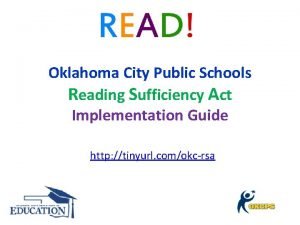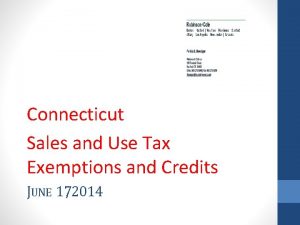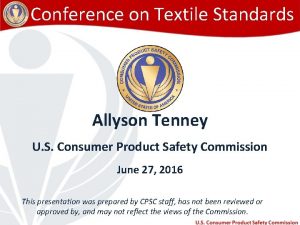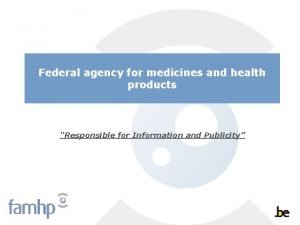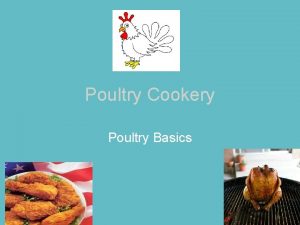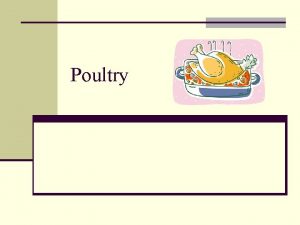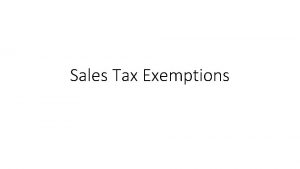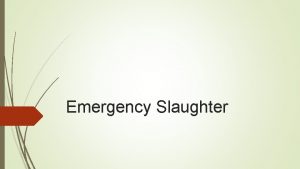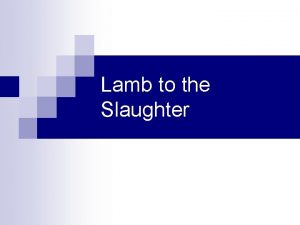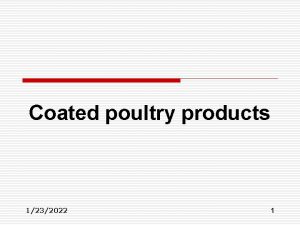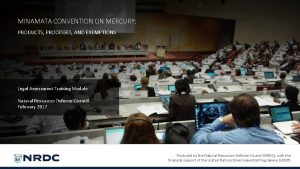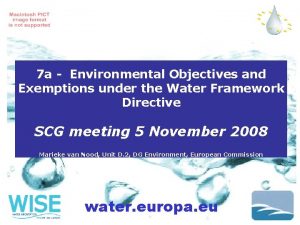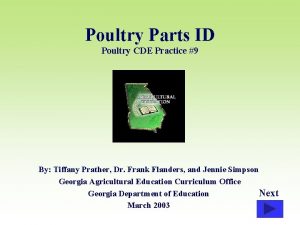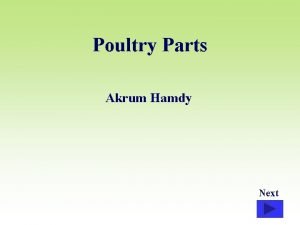Poultry Slaughter Exemptions Under the Federal Poultry Products

















- Slides: 17

Poultry Slaughter Exemptions Under the Federal Poultry Products Inspection Act and the SC Poultry Products Inspection Law

What does the law say regarding poultry products? Two Exemptions 1. Producer/Grower 1, 000 Poultry Limit Exemption • Poultry Products Inspection Act (PPIA) Section 464(c)(4) “Section 15 (c)(4)” • Title 9 CFR § 381. 10(c) –adopted by state regulations – A person may slaughter and process, on his or her own premises, poultry that s/he raised and may distribute such poultry without mandatory (daily) inspection. – The limited provisions of this exemption apply to poultry growers who slaughter no more than 1, 000 birds in a calendar year for use as human food. 2

To operate under the 1, 000 bird exemption, the following requirements must be met. 1. The producer /grower slaughters no more than 1, 000 healthy birds of his/her own raising in a calendar year. 2. The producer /grower does not engage in buying or selling poultry products other than those produced from poultry raised on his/her own farm. 3. Slaughter and processing are conducted following the general guidelines of basic sanitary standards such that the end product is sound, clean and fit for human consumption. 4. The producer or grower keeps accurate and legible records necessary for effective enforcement of the Act. 5. The product is properly labeled. 6. The poultry products may be sold only within the State of South Carolina. (It is the producers responsibility to determine if specific outlets will accept uninspected products. 7. The producer/grower must be registered as a Meat and Poultry Handler (Call SCMPID at 803 -788 -8747. ) 3

What does the law say regarding poultry products? Two Exemptions 2. Producer/Grower 20, 000 Poultry Limit Exemption • PPIA Section 464(c)(1)(C) &(c)(3) “Section 15 (c)(4)” • Title 9 CFR § 381. 10(a)(5) and (b)(1) and (2)—adopted by state regulations – A person may slaughter and process, on his or her own premises, poultry that s/he raised and may distribute such poultry without mandatory (daily) inspection. – The limited provisions of this exemption apply to poultry growers who slaughter no more than 20, 000 birds in a calendar year for use as human food. 4

To operate under the 20, 000 bird exemption, the following requirements must be met. 1. The producer /grower slaughters no more than 20, 000 healthy birds of his/her own raising in a calendar year. 2. The producer /grower does not engage in buying or selling poultry products other than those produced from poultry raised on his/her own farm. Further, s/he may not buy or sell poultry products produced under any other exemption during the same calendar year. 3. The producer/grower may only distribute poultry products produced under this exemption. 4. Slaughter and processing are conducted at the producer/ grower’s premises using sanitary standards, practices and procedures (Basic Sanitary Standards) that produce poultry products that are sound, clean and fit for use as human food (not 5 adulterated. )

To operate under the 20, 000 bird exemption, the following requirements must be met (cont. ) 5. The producer/grower’s facility cannot be used to slaughter or process any other person’s poultry. 6. The producer or grower keeps accurate and legible records necessary for effective enforcement of the Act. 7. The product is properly labeled. 8. The poultry products may be sold only within the State of South Carolina. (It is the producers responsibility to determine if specific outlets will accept uninspected products. 9. The producer/grower must be registered as a Meat and Poultry Handler (Call SCMPID at 803 -788 -8747. ) 6

Basic Sanitary Standards • Following are general basic sanitary standards, practices, and procedures [9 CFR 416. 2 -416. 5]. The list is a summary of the regulatory requirements for sanitation procedures and practices that are required for a poultry business receiving full U. S. Department of Agriculture inspection and are applicable to poultry exempt operations {Title 9 CFR Part 416}. A. Sanitary operating conditions. All food-contact surfaces and non-foodcontact surfaces of an exempt facility are cleaned and sanitized as frequently as necessary to prevent the creation of insanitary conditions and the adulteration of product. Cleaning compounds, sanitizing agents, processing aids, and other chemicals used by an exempt facility are safe and effective under the conditions of use. Such chemicals are used, handled, and stored in a manner that will not adulterate product or create insanitary conditions. Documentation substantiating the safety of a chemical's use in a food processing environment are available to inspection program employees for review. Product is protected from adulteration during processing, handling, storage, loading, and unloading and during transportation from official establishments. 7

Basic Sanitary Standards B. Grounds and pest control. The grounds of exempt operation are maintained to prevent conditions that could lead to insanitary conditions or adulteration of product. Plant operators have in place a pest management program to prevent the harborage and breeding of pests on the grounds and within the facilities. The operator's pest control operation is capable of preventing product adulteration. Management makes every effort to prevent entry of rodents, insects, or animals into areas where products are handled, processed, or stored. Openings (doors and windows) leading to the outside or to areas holding inedible product have effective closures and completely fill the openings. Areas inside and outside the facility are maintained to prevent harborage of rodents and insects. The pest control substances used are safe and effective under the conditions of use and are not applied or stored in a manner that will result in the adulteration of product or the creation of insanitary conditions. 8

Basic Sanitary Standards C. Sewage and waste disposal systems properly remove sewage and waste materials—feces, feathers, trash, garbage, and paper— from the facility. Sewage is disposed of into a sewage system separate from all other drainage lines or disposed of through other means sufficient to prevent backup of sewage into areas where product is processed, handled, or stored. When the sewage disposal system is a private system requiring approval by a State or local health authority, upon request, the management must furnish to the inspector a letter of approval from that authority. D. Water supply and water, ice, and solution reuse. A supply of running water that complies with the National Primary Drinking Water regulations (40 CFR part 141) at a suitable temperature and under pressure as needed, is provided in all areas where required (for processing product; for cleaning rooms and equipment, utensils, and packaging materials; for employee sanitary facilities, etc. ). If a facility uses a municipal water supply, it must make available to the inspector, upon request, a water report, issued under the authority of the State or local health agency, certifying or attesting to the potability of the water supply. If a facility uses a private well for its water supply, it must make available to the inspector, upon request, documentation certifying the potability of the water supply that has been renewed at least semi-annually. 9

Basic Sanitary Standards E. Facilities. Maintenance of facilities during slaughtering and processing is accomplished in a manner to ensure the production of wholesome, unadulterated product. F. Dressing rooms, lavatories, and toilets. Dressing rooms, toilet rooms, and urinals are sufficient in number ample in size, conveniently located, and maintained in a sanitary condition and in good repair at all times to ensure cleanliness of all persons handling any product. Dressing rooms, lavatories, and toilets are separate from the rooms and compartments in which products are processed, stored, or handled. G. Inedible Material Control. The operator handles and maintains inedible material in a manner that prevents the diversion of inedible animal products into human food channels and prevents the adulteration of human food. 10

Record Keeping Requirements (Applicable to either Exception) • The number of birds, by date slaughtered, that are slaughtered in a calendar year. • The number of birds, by sale date, that are sold to customers in a calendar year. • Current (within one year) laboratory test for water potability. • Records are subject to review by FSIS or SCMPID employees to determine compliance with the requirement for sales not to exceed 1, 000 (or 20, 000) poultry in a calendar year. • Maintain all records for the slaughtering and sale of poultry products to customers for two (2) years. 11

LABELING (Applicable to Either Exception) All poultry or poultry products produced under either exemption must be labeled with the following: a. The processor’s name b. The processor’s address, c. The statement: Exempt – P. L. 90 -492 d. Safe handling instructions 12 12


Poultry Exemptions (Example Enforcement Criteria) • End product – Must be clean and fit for human consumption – free from adulteration – Must be properly labeled • Record Keeping – Must be accurate, legible and contain sufficient detail necessary for effective enforcement of the law. • Current water potability certificate.

So, what if I don’t comply? • “A person violating a section of Title 47 {…} is guilty of a misdemeanor and, upon conviction, must be fined not more than the amount authorized as the jurisdictional maximum for a summary court ($1000) or imprisoned not more than that period of time authorized as the jurisdictional maximum for a summary court , or both, for a first offense and in the discretion of the court for a second offense. ”

South Carolina Meat & Poultry Inspection Department (SCMPID) • Established as a part of Clemson University - Public Service Activities (PSA) – Unique among state inspection programs – most under Department of Agriculture or Health – “Education through Regulation” • Headquartered in Columbia within the Livestock Poultry Health Division, 803 -788 -8747 • Director: Dr. Suzanne K. Southworth, ssouthw@clemson. edu • Senior Compliance Officer: Mr. Terry Dempsey, terry. dempsey@fsis. usda. gov

QUESTIONS?
 Oklahoma rsa good cause exemptions
Oklahoma rsa good cause exemptions Connecticut manufacturing sales tax exemption
Connecticut manufacturing sales tax exemption 16 cfr 1610 exemptions
16 cfr 1610 exemptions Federal agency for medicines and health products
Federal agency for medicines and health products Functional and innovative products supply chain
Functional and innovative products supply chain Coke vs pepsi sales
Coke vs pepsi sales 101012 bằng
101012 bằng Lời thề hippocrates
Lời thề hippocrates đại từ thay thế
đại từ thay thế Tư thế worms-breton
Tư thế worms-breton Quá trình desamine hóa có thể tạo ra
Quá trình desamine hóa có thể tạo ra Công thức tính độ biến thiên đông lượng
Công thức tính độ biến thiên đông lượng Sự nuôi và dạy con của hươu
Sự nuôi và dạy con của hươu Thế nào là mạng điện lắp đặt kiểu nổi
Thế nào là mạng điện lắp đặt kiểu nổi Dot
Dot Nguyên nhân của sự mỏi cơ sinh 8
Nguyên nhân của sự mỏi cơ sinh 8 Bổ thể
Bổ thể Vẽ hình chiếu đứng bằng cạnh của vật thể
Vẽ hình chiếu đứng bằng cạnh của vật thể
